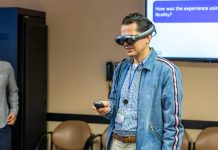By Morris Graham and Kevin Baize
Twenty-first-century America demands ultra-smart leaders—those who securely possess both the thinking capacity and skills to come to grips with accelerating and unpredictable changes in complex, often chaotic, environments. These brilliant leaders should know how to think in verbal, quantitative, and spatial dimensions simultaneously to get the most out of emergent trends; resolve seemingly intractable contradictions; discern insight from perplexity; and design futures through decisiveness, direction, and speed. They should be “wired in” to the idea spaces of our uncertain times. With nimbleness, connectivity, and inventiveness they should come up with new ideas rather than hoping ideas will fortuitously arrive. Higher, wider, deeper, and accelerated processing capacities for thinking should enable them to three-dimensionally hold competing and conflicting ideas simultaneously, grasping and integrating important pieces in their minds at once. They should quickly resolve the irrelevant issues and decisively craft superior global frameworks with four-dimensional insight, velocity, and direction. In truth, they should and will welcome complex and challenging problems because they believe better insights will come more wisely through the crush of opposing views.
This overwhelming demand for ultra-smart leaders begs two questions:
- Where do we find such leaders? And more importantly,
- Can we train and develop an elite cadre of talent?
After years of executive research and development on three continents, we introduce a brain-stimulating neuroscience approach to executive development. Our travels and writings suggest that the few we found who demonstrated extraordinary problem-solving were loaded with spatial capacity—insight, plasticity, and directionality—able to hold objectively the multidimensional streams of consciousness required in a higher level of complexity. These few executives were able to view their linear world of unseen multiple options in three- and four-dimensional frameworks. They were like quarterbacks, able to take a backfield vantage point, where unfolding dynamic systems were simultaneously perceived in spatial combinations of height, width, and depth and directed with insight, decisiveness, direction, and speed.
Our book, “Executive Thinking: from Brightness to Brilliance,” primarily addresses the second question: Can spatially gifted, ultra-smart executives be developed? Yes, thanks to exciting breakthroughs in neural science. We outline an integrative model of four “brights” to brilliance and document a phenomenal neural technology of visual informational processing (VIP) training needed to increase capacity—to turbo-charge the right hemisphere of the brain for greater cross-connectivity and spatial assimilation to better accommodate new data. In other words, an executive’s creative abilities can be ultra-activated by increasing his/her capacity to connect normally disconnected thoughts, memories, feelings, and ideas. This means we can learn to mentally process in a way that we can proceed from different starting points, change direction as needed, and spontaneously generate many unusual, possible solutions or distantly associated answers—each of which could be correct, useful, relevant, or effective and appropriate. Such a capacity for hyper-connectivity, we believe, is at the heart of all forms of brilliant thinking. Our “Thinking Postulate” states: Reasoning and problem-solving are no stronger than one’s visual-spatial processing capacity that incorporates information on what is going on in real time and space.
Visualize going through a supermarket “loaded” with ideas about what to eat, most of which we could not remember if we were not in that environment. But as we walk through the aisles, each item reminds us of what we might have for dinner. As a result, we can generate many ideas in a relatively short period of time. The more things we can generate as ideas, the more options we have to work with. If we were to include in our nutritional selection antioxidants and omega-3 fatty acids, we would better feed our brains over time. Likewise, differences in information-generation capacity—sourcing, retrieving, and processing—should not be static, but can be significantly improved with visual-spatial practice. Our visual-spatial capacity is defined as our mental ability to represent the outer world internally in our mind. It’s the ability to hold the world visually in our minds the way a sailor or pilot navigate their large spatial world, or the way a chess player or sculptor represents a more circumscribed spatial world. It gives us the capacity to know where we are in space. If we find it easy to visualize things as though we were an observer taking up different positions, like a fly on the wall, than we are strong in this ability.
We make a case that the most powerful brains are the ones where many parts of the brain are ultra-activated and processing simultaneously on a regular basis. So how do we achieve this? Exercise! Brain exercise—giving all the different parts a workout to develop new mental muscles so they will join in on the everyday processing to make our brains more hyper-connected and smarter. The more we exercise the different parts of our brains, the more we get all the spatial sparkplugs of our brains firing and contributing, thereby creating more processing capacity. For any of their executives to advance to brilliance, the authors had to first discover, beg, borrow, and invent “spatial” processing workouts for the right hemisphere. Ultimately, both hemispheres are needed to help executives learn to think insightfully in three and four dimensions, the way geniuses do.
We invite readers to break away from years of flat thinking or educational backgrounds that stifle creative/innovative potential. We now have the neural technology to develop the capacity to think higher, wider, thicker, and deeper and thereby become more creative, inventive, and brilliant. Expand your mental agility through a development of higher-order processes and discover a whole new world mentally in “Executive Thinking.”
Morris Graham and Kevin Baize are the authors of “Executive Thinking: From Brightness to Brilliance” (iUniverse, 2011).
Morris Graham heads a Honolulu-based, international executive/organization development firm. He received a Ph.D. in cognitive-developmental psychology from the University of Arizona and a Post-Doctorate in Organization Psychology from Edinburgh University, Scotland. Dr. Graham is internationally recognized for his expertise in organizational capacity building and is the author of “The Horizontal Revolution.”
Kevin Baize is a scientist and expert in visual informational processing technologies (VIPT). He has more than 17 years of experience in the field. Dr. Baize presently heads the Hawaii Science Academy for developing visual-spatial giftedness.




